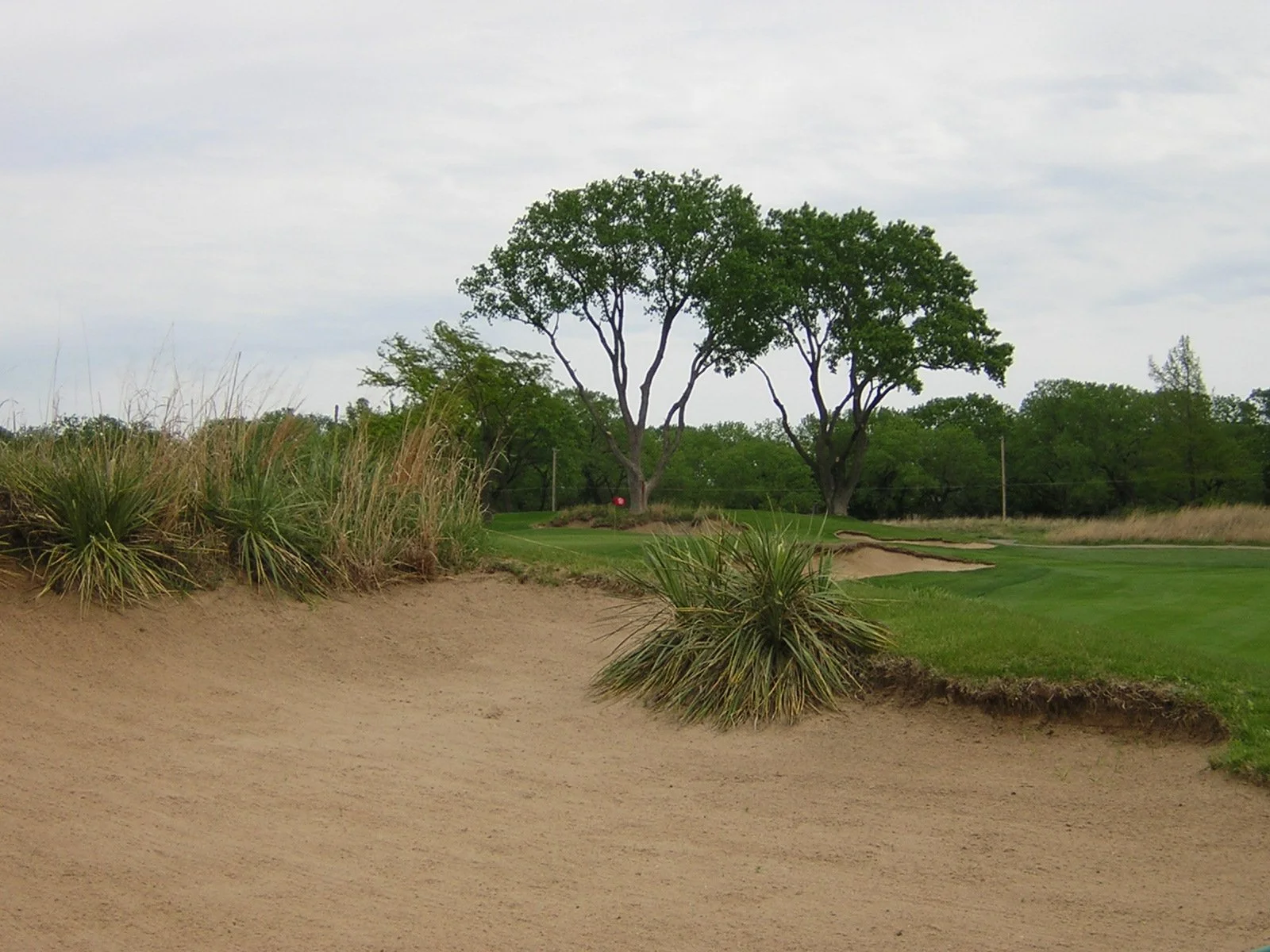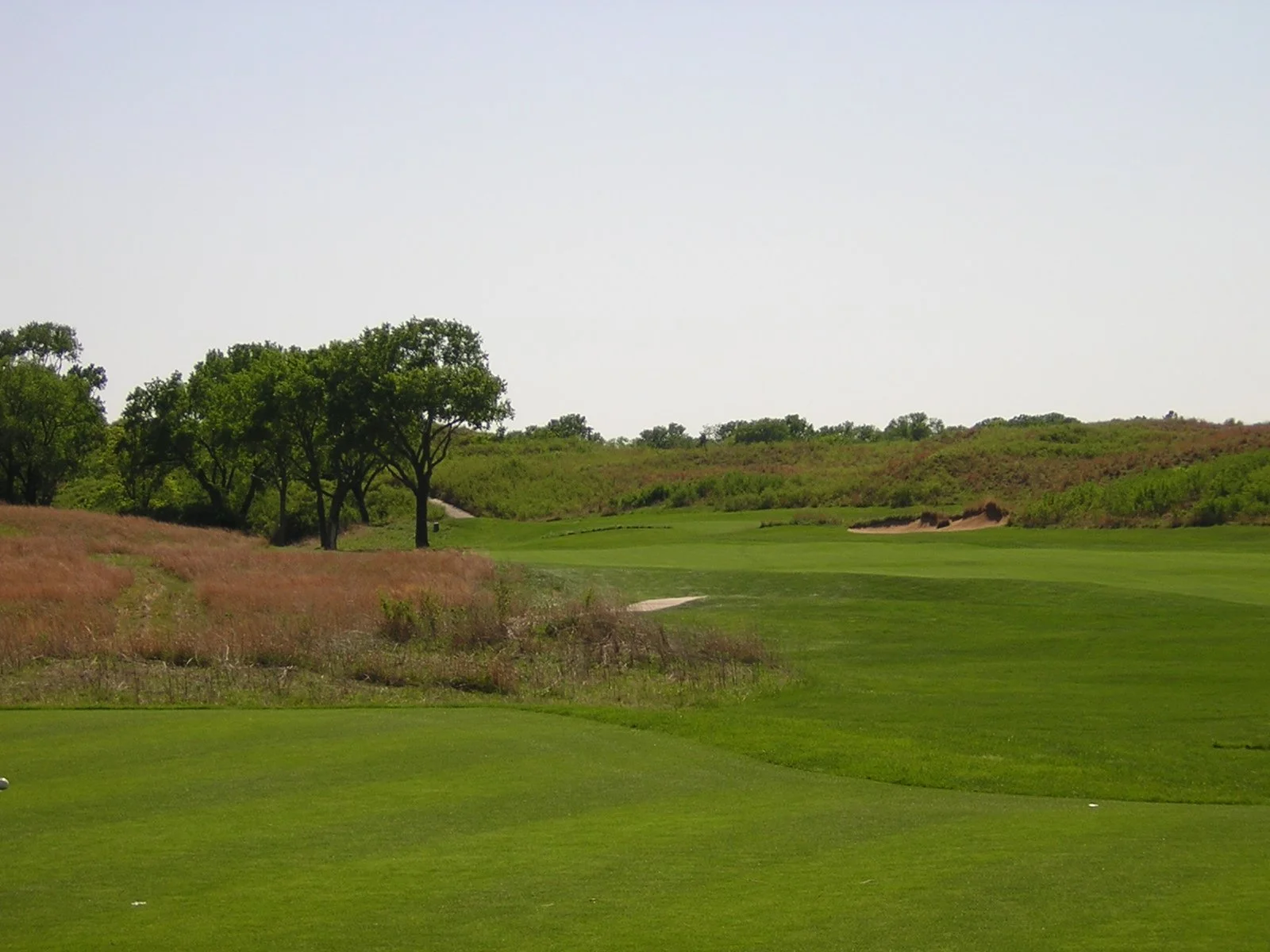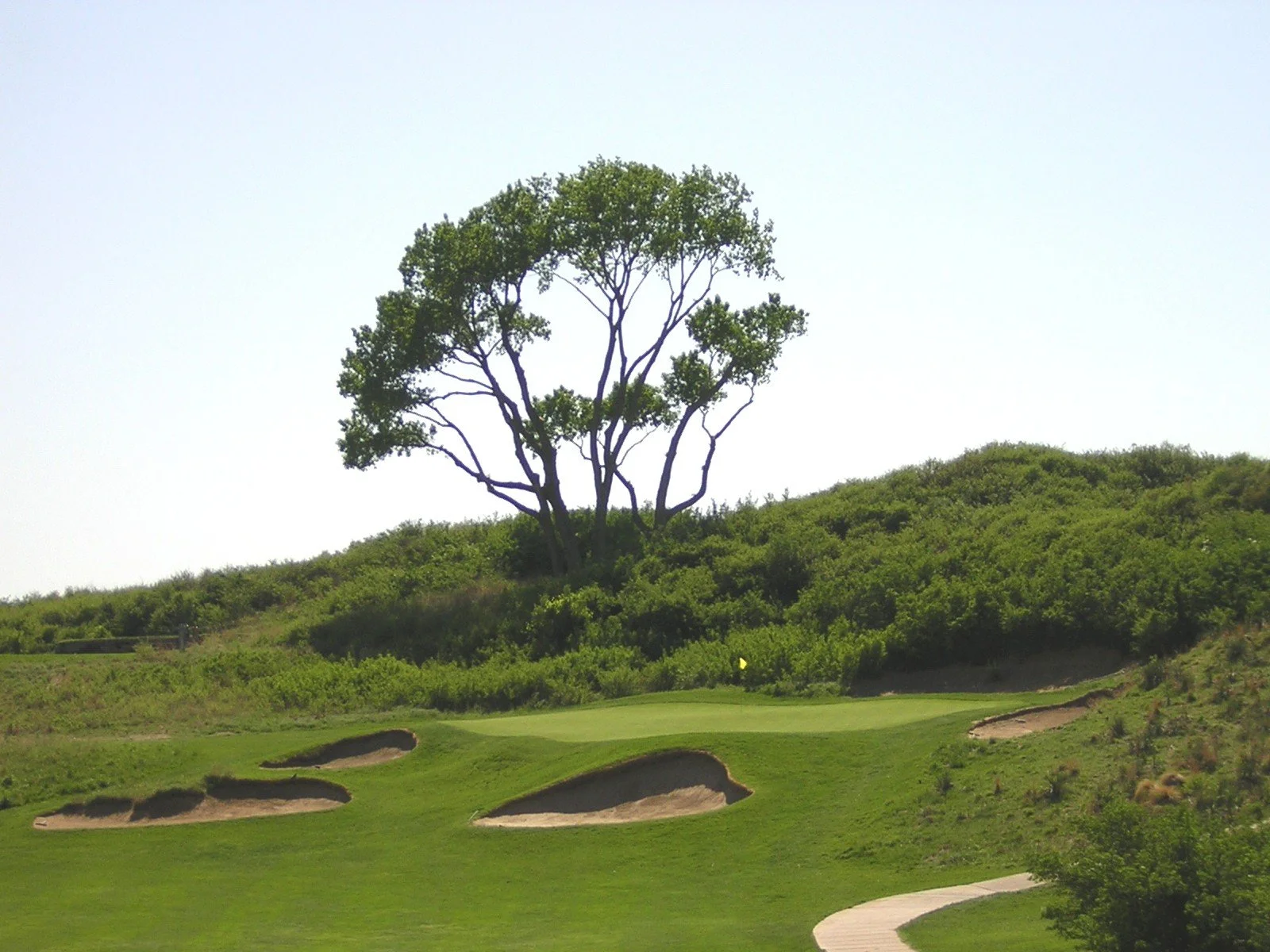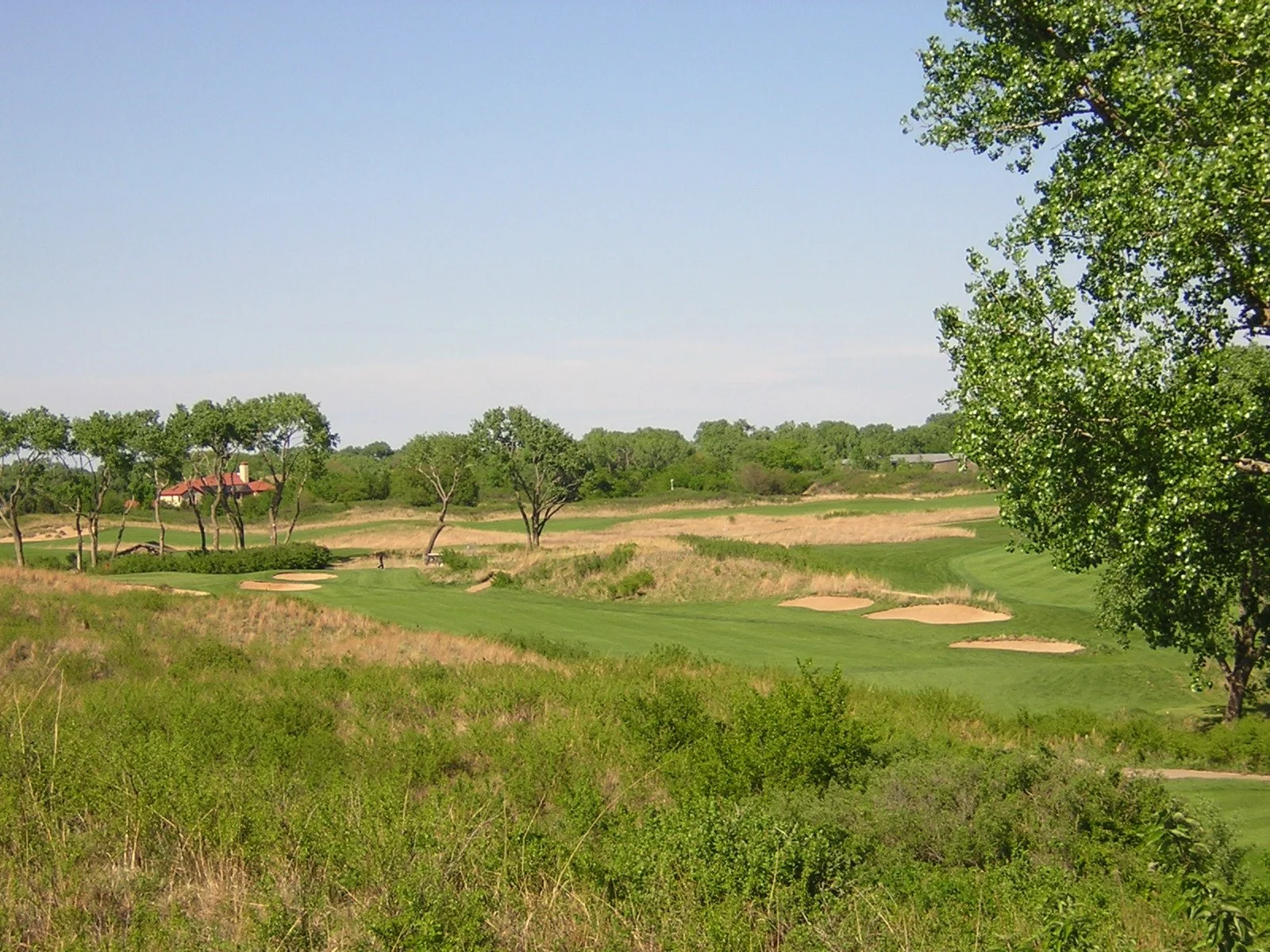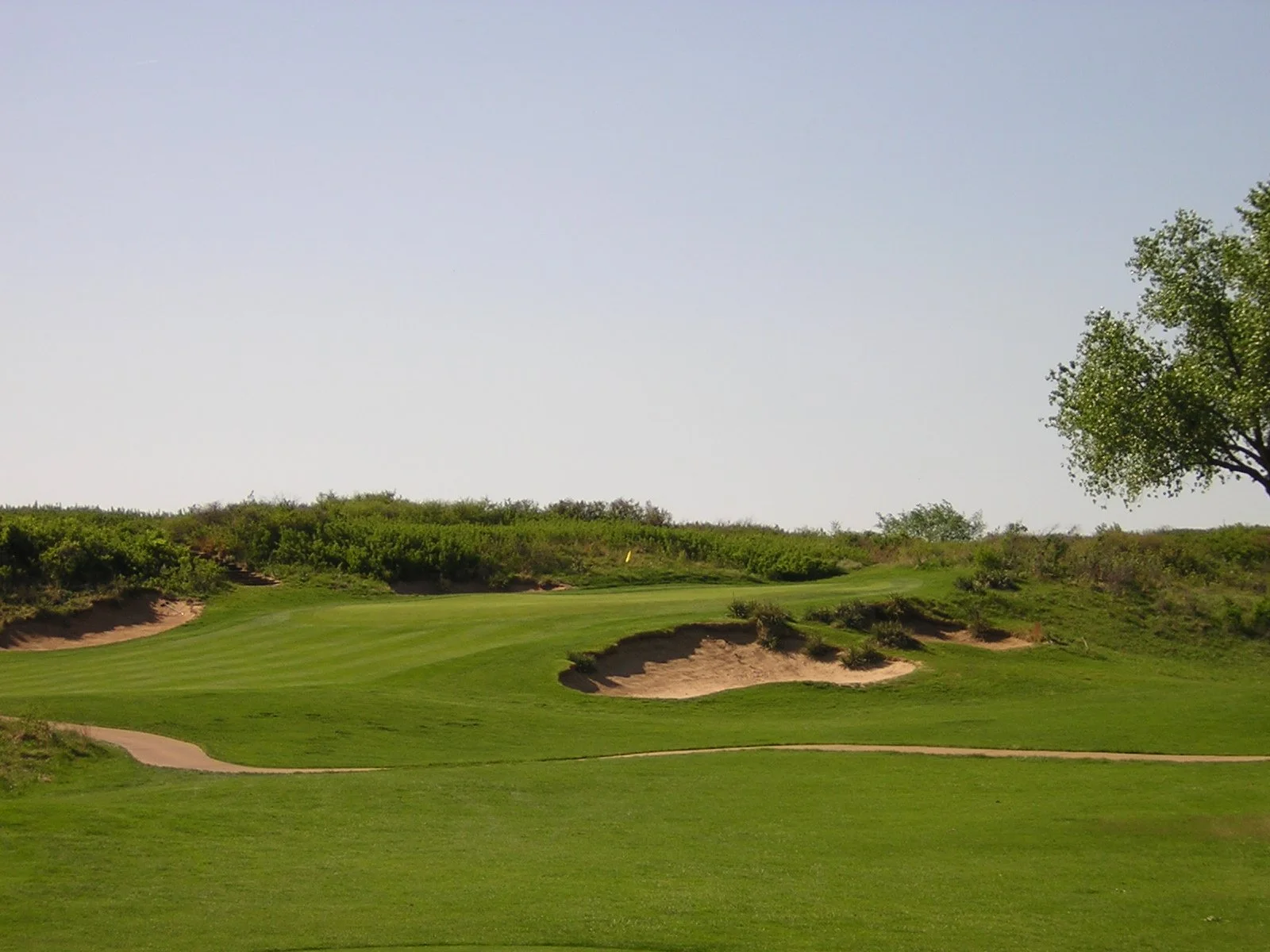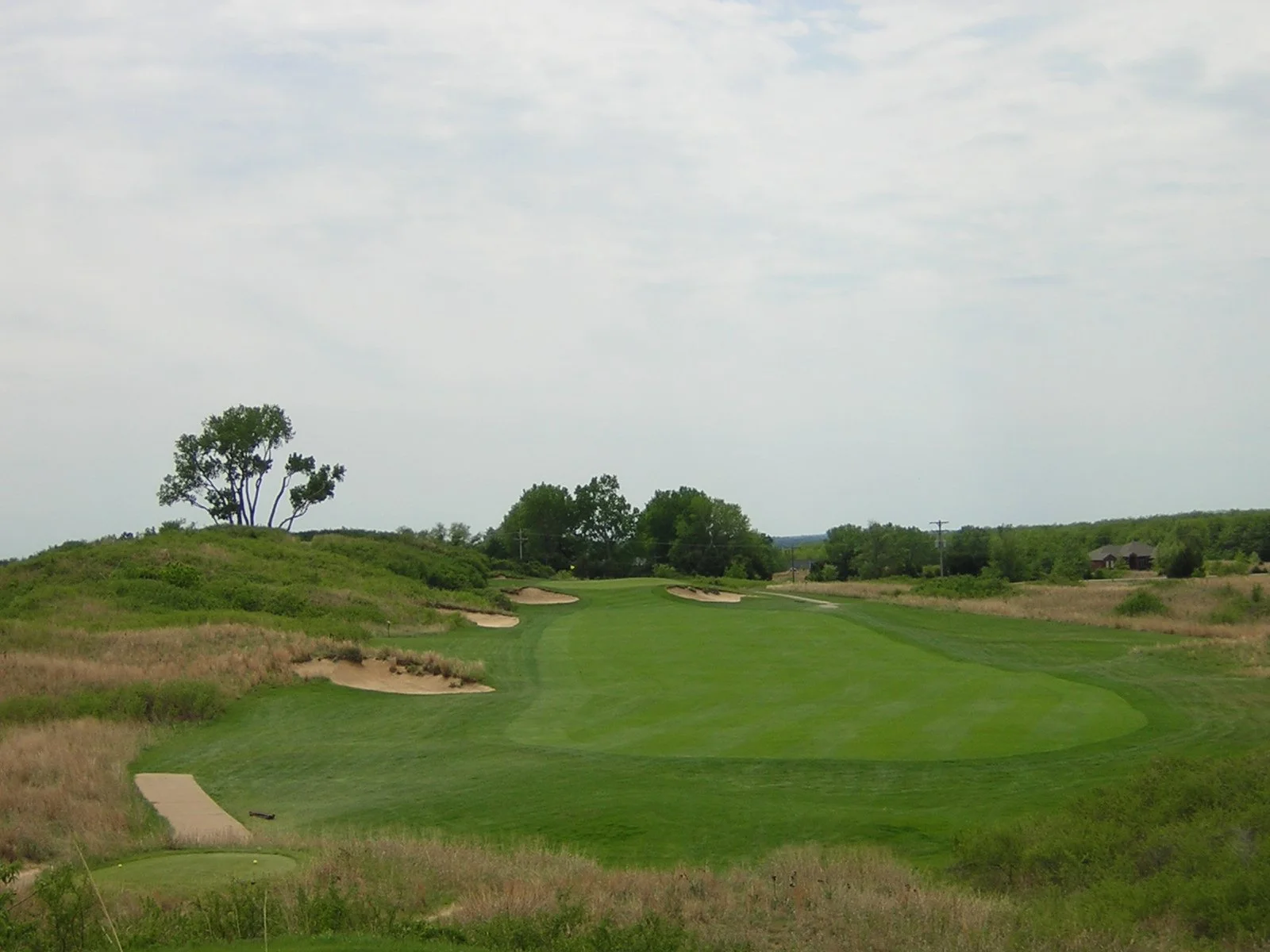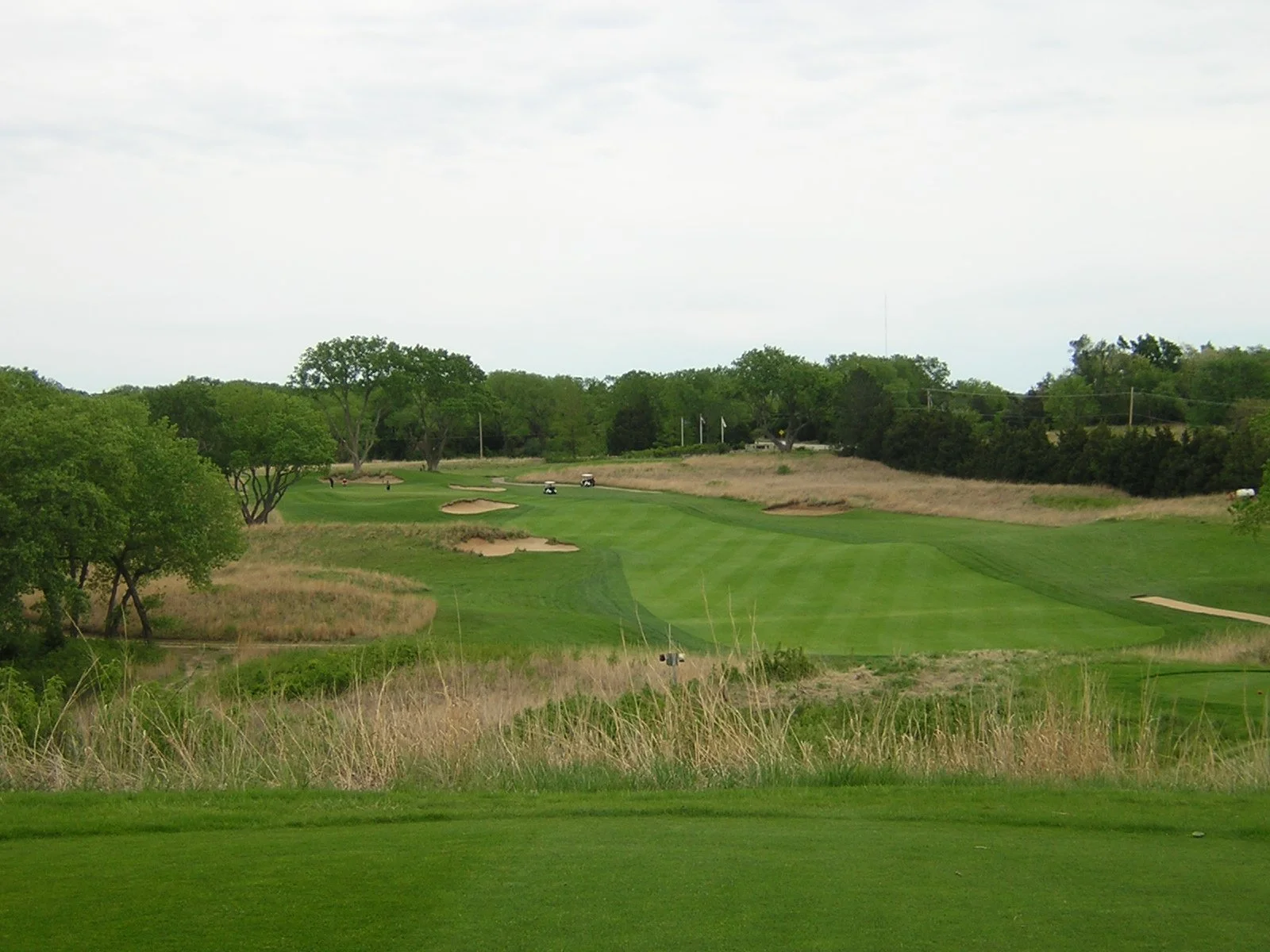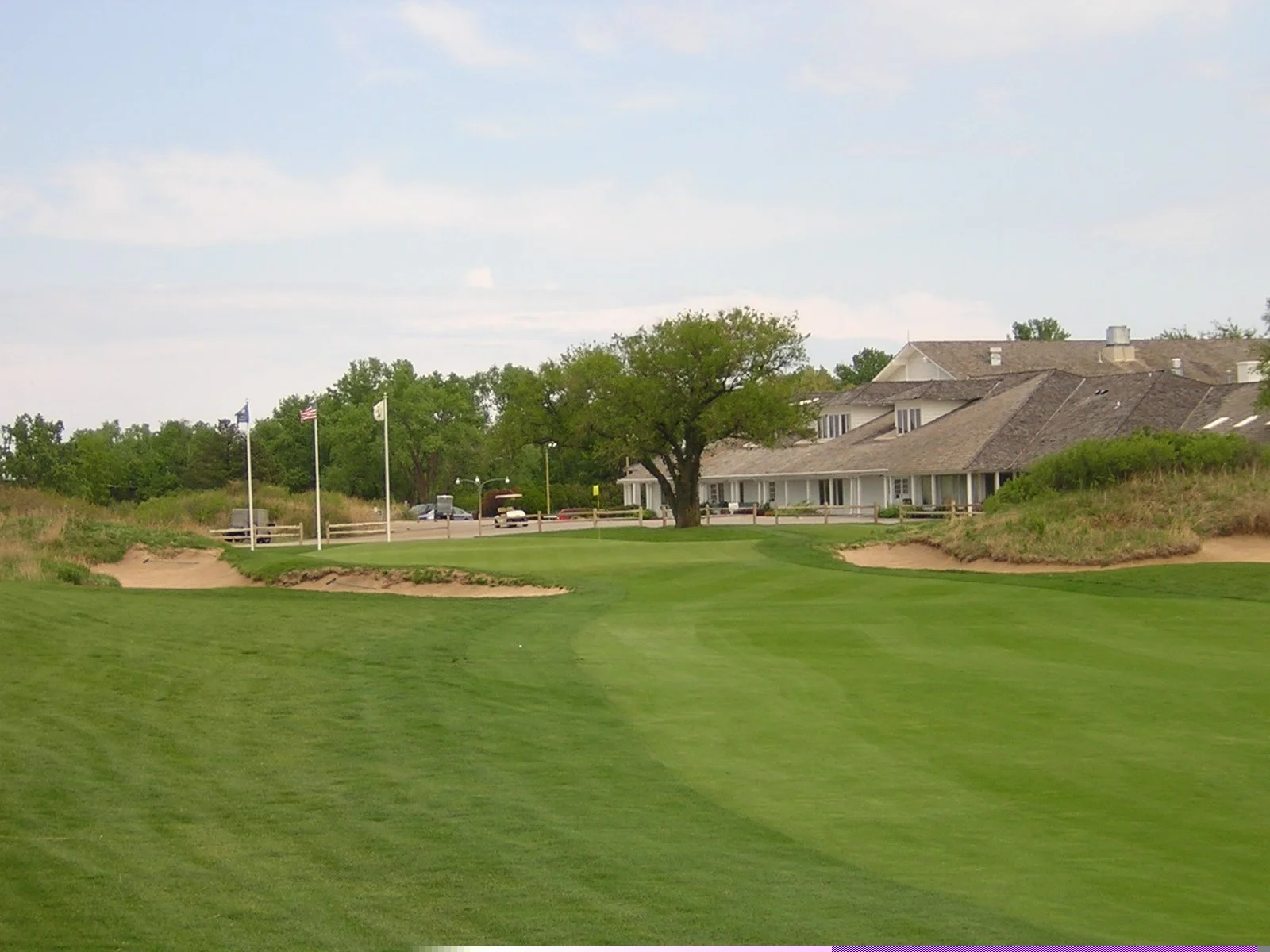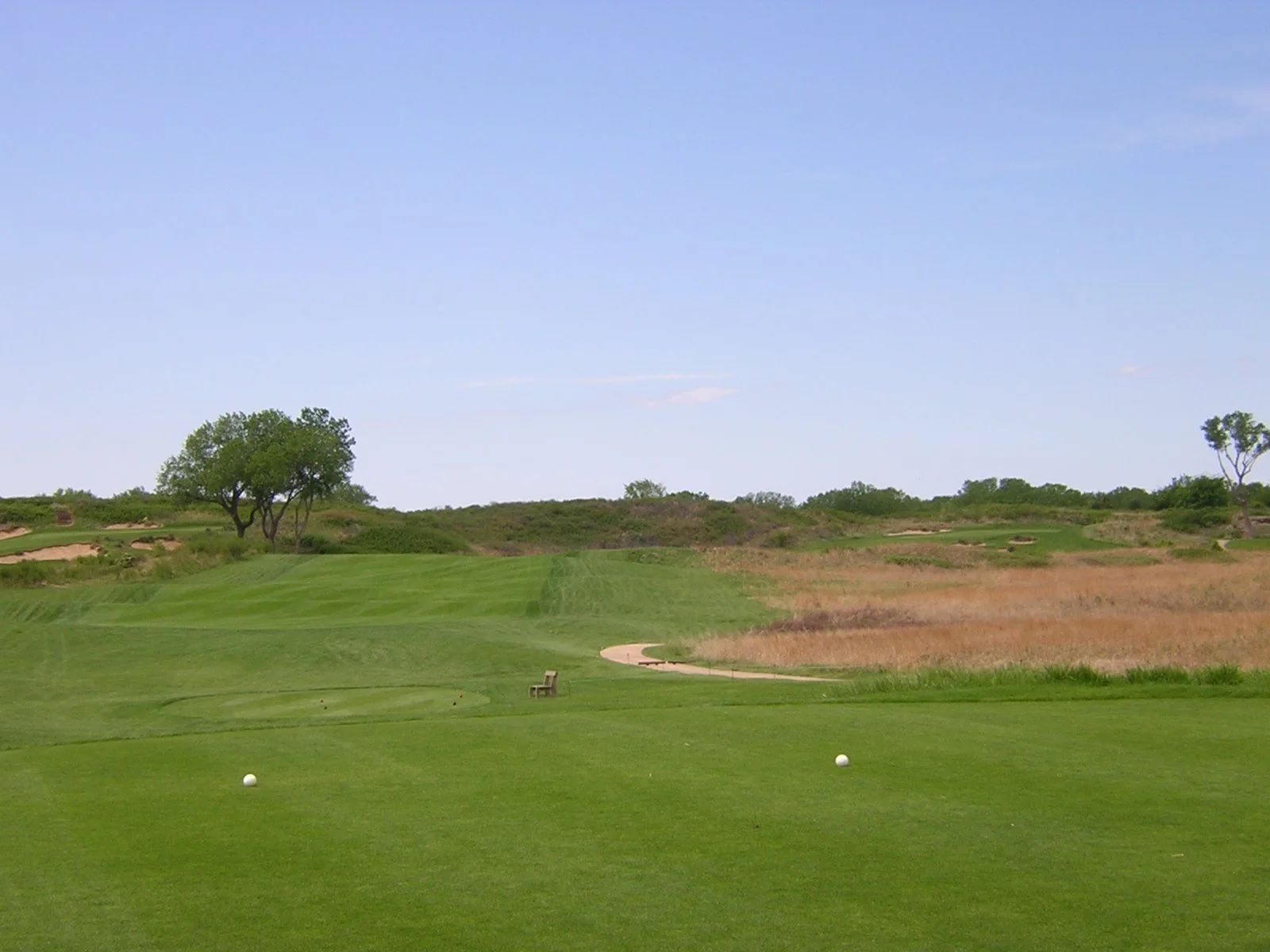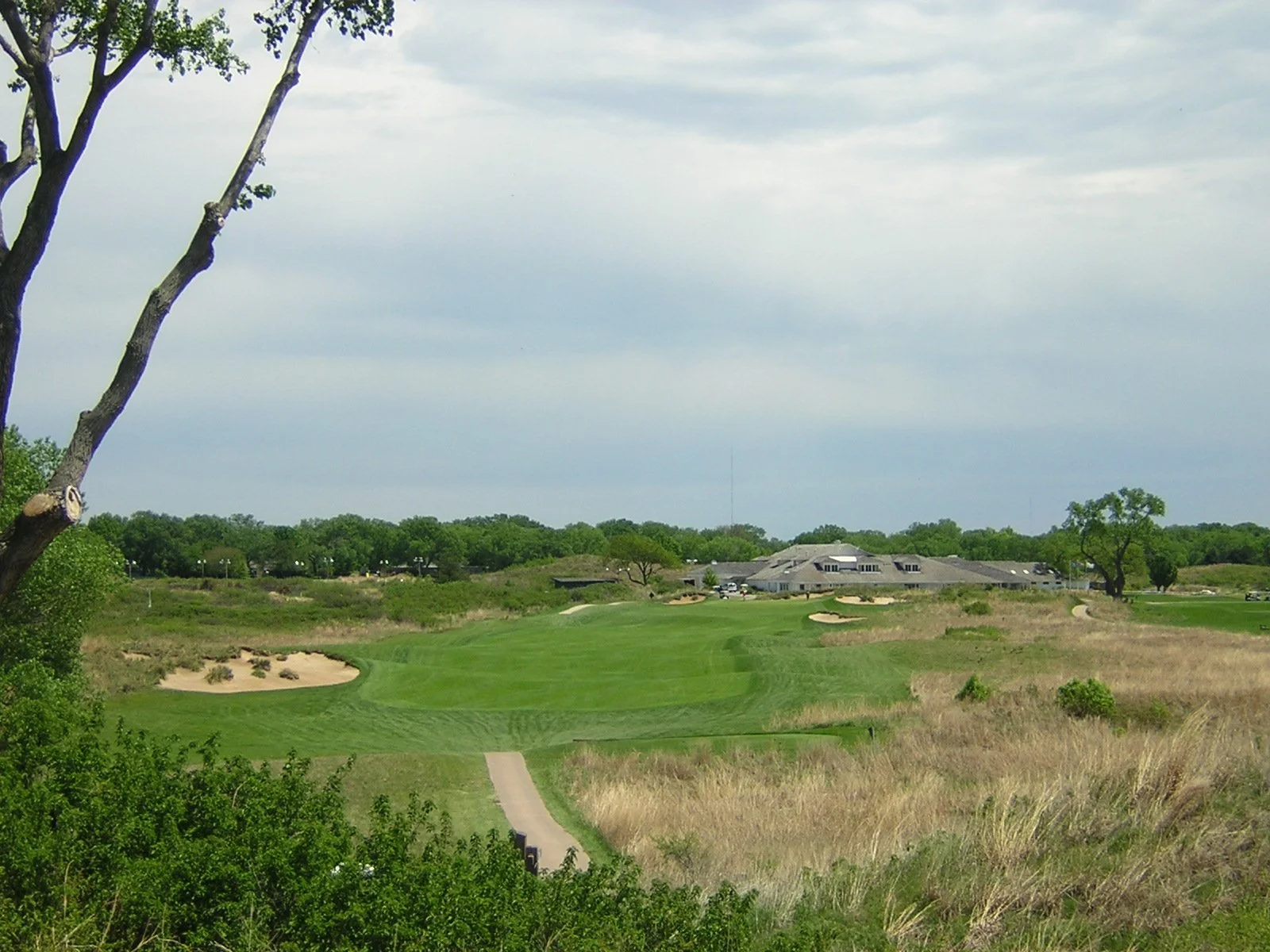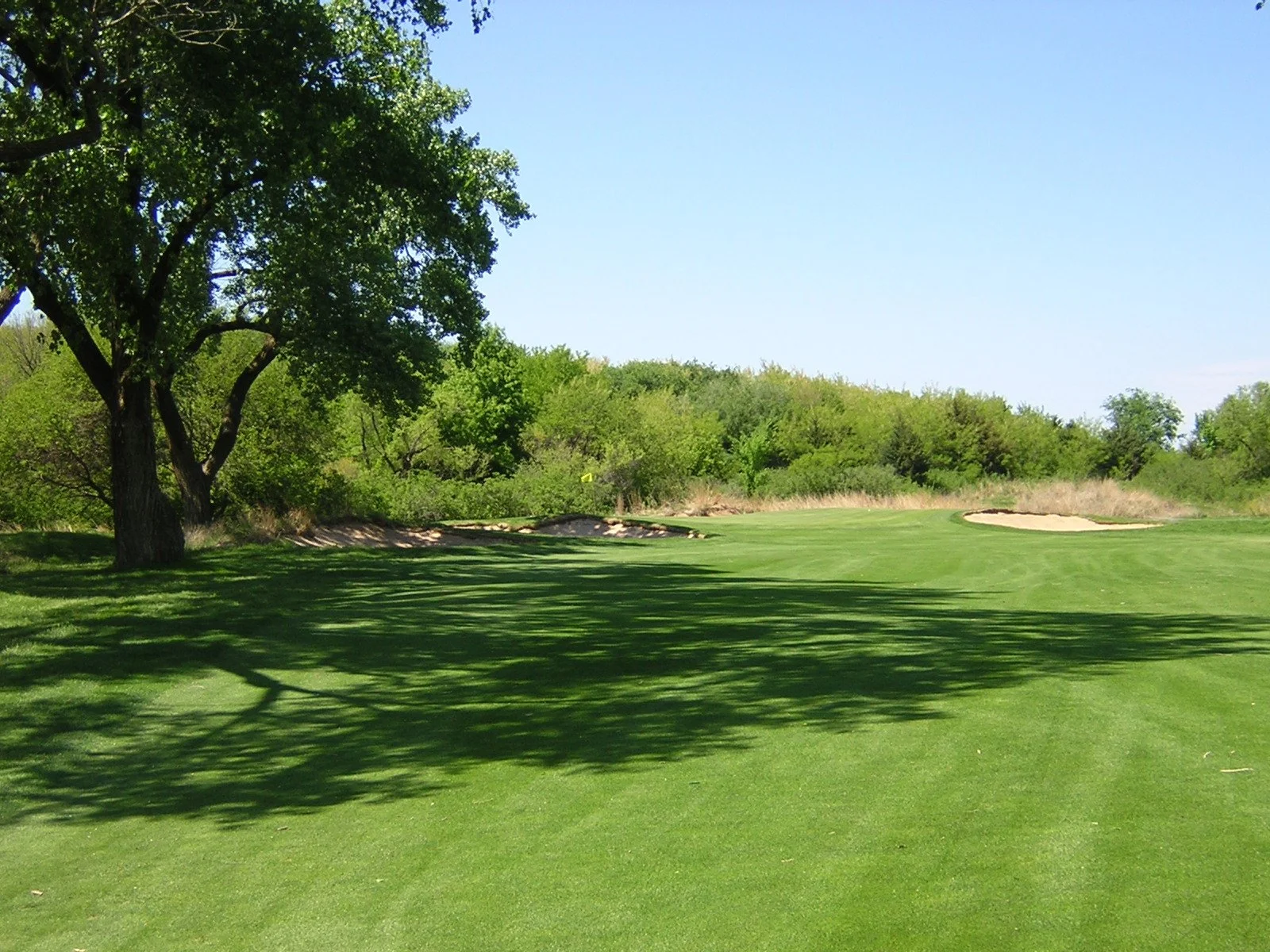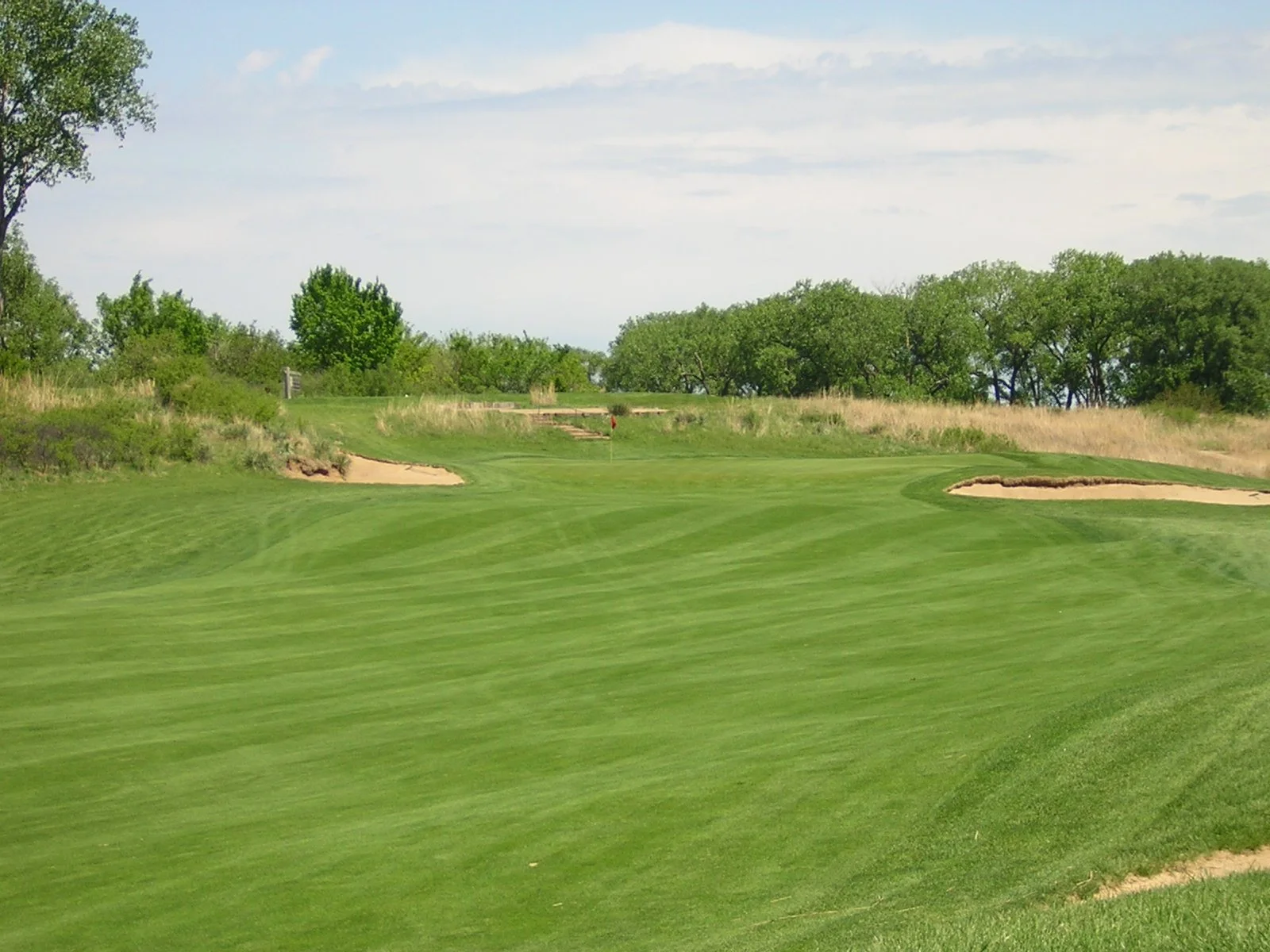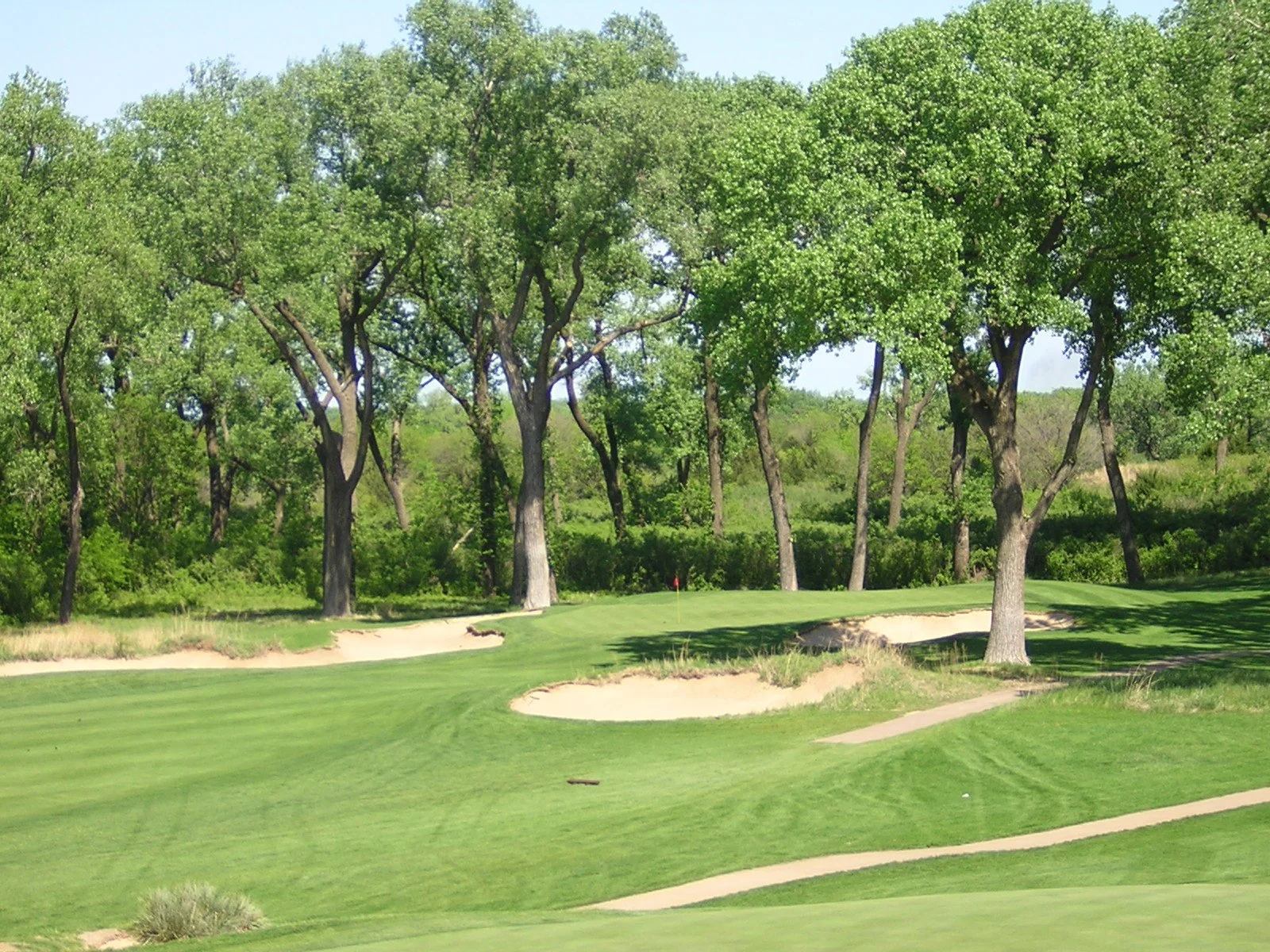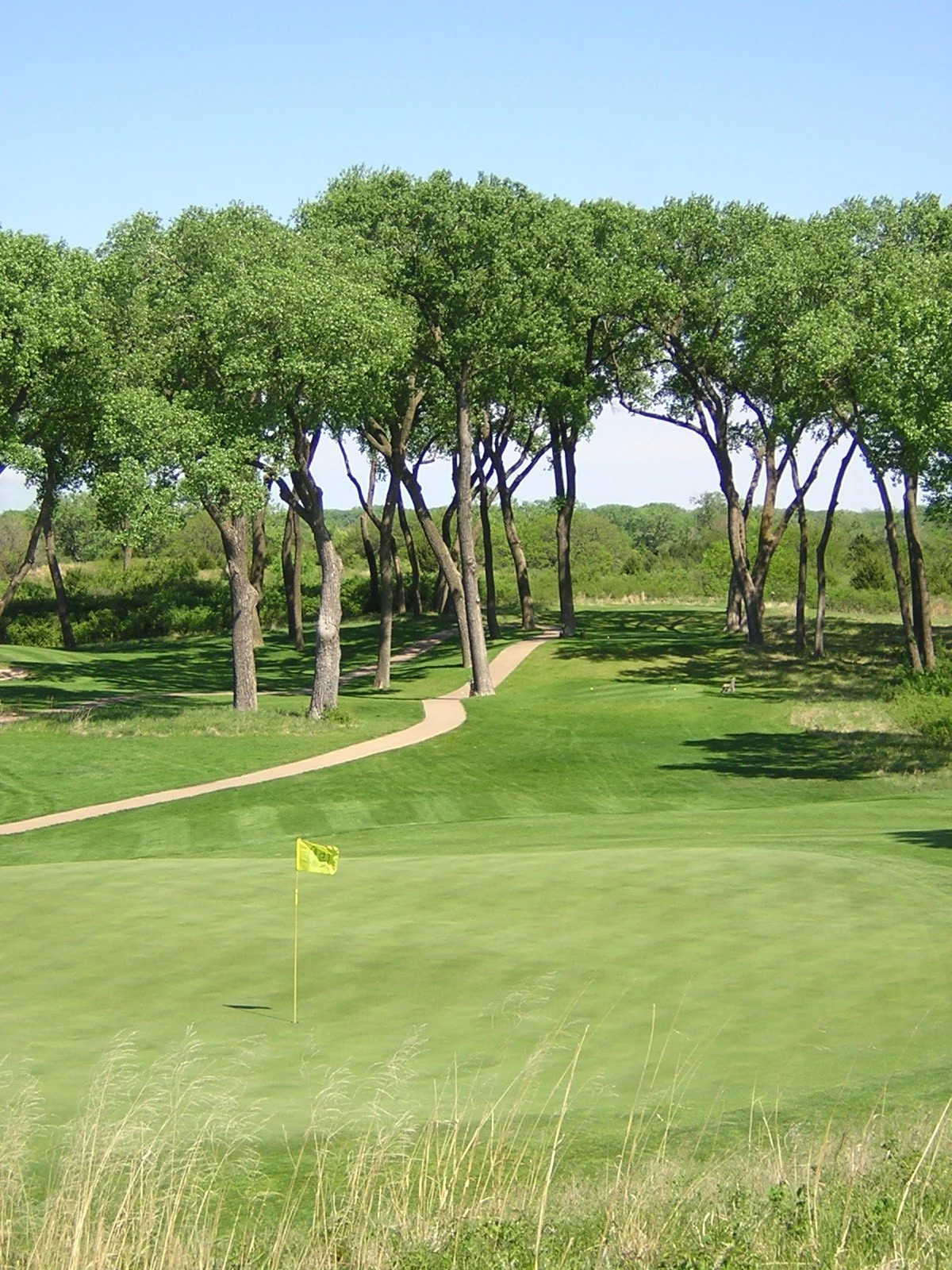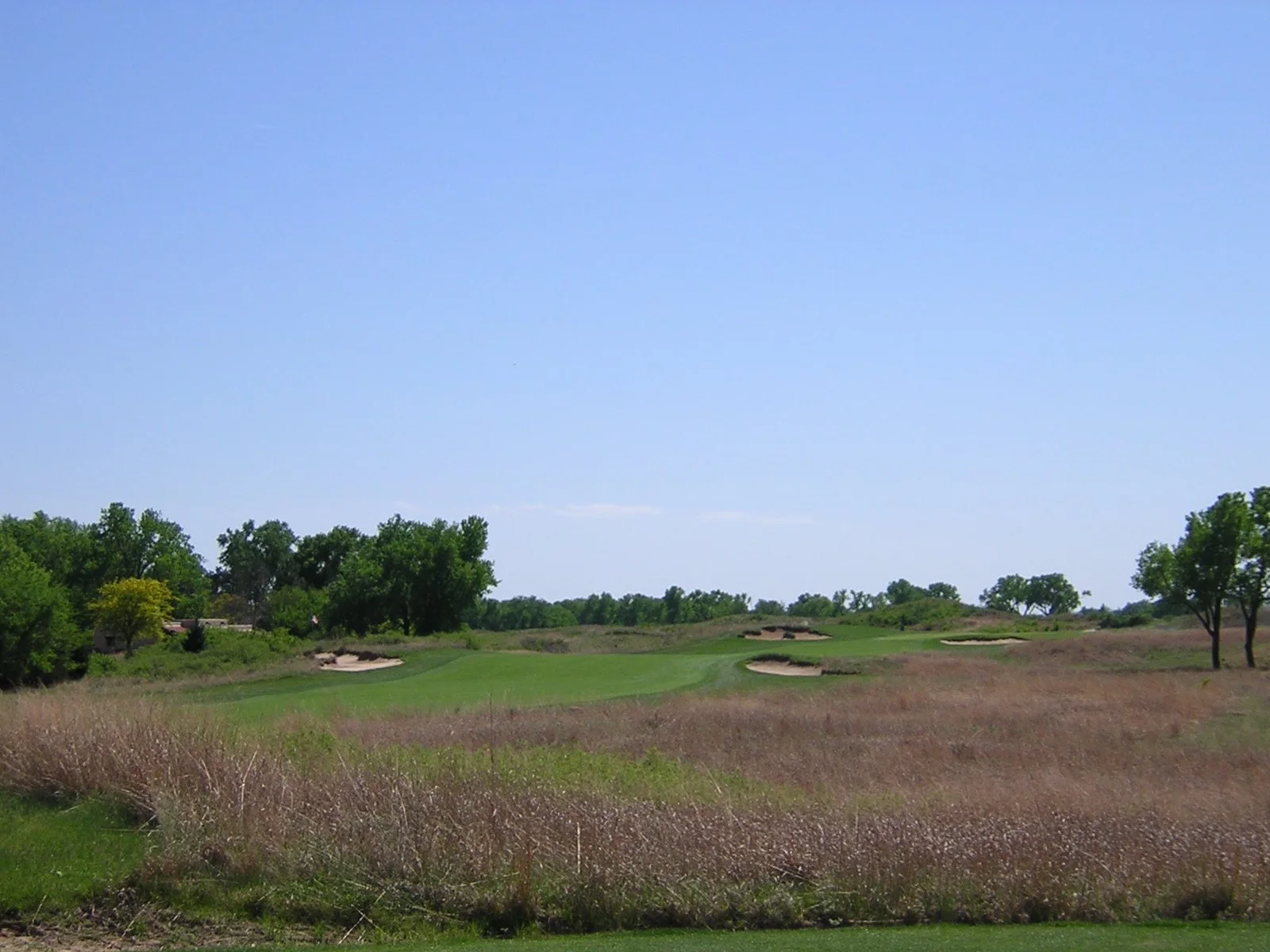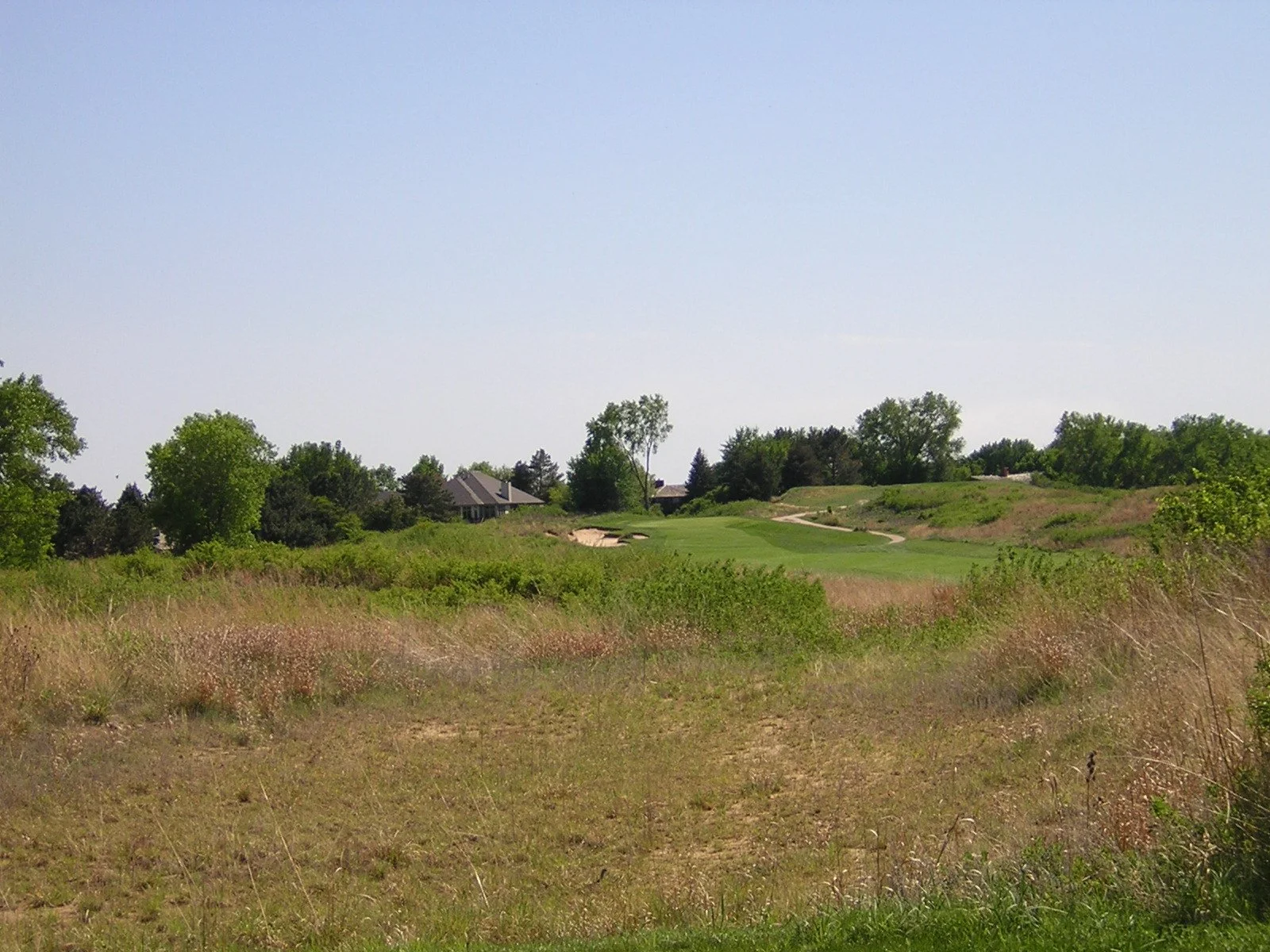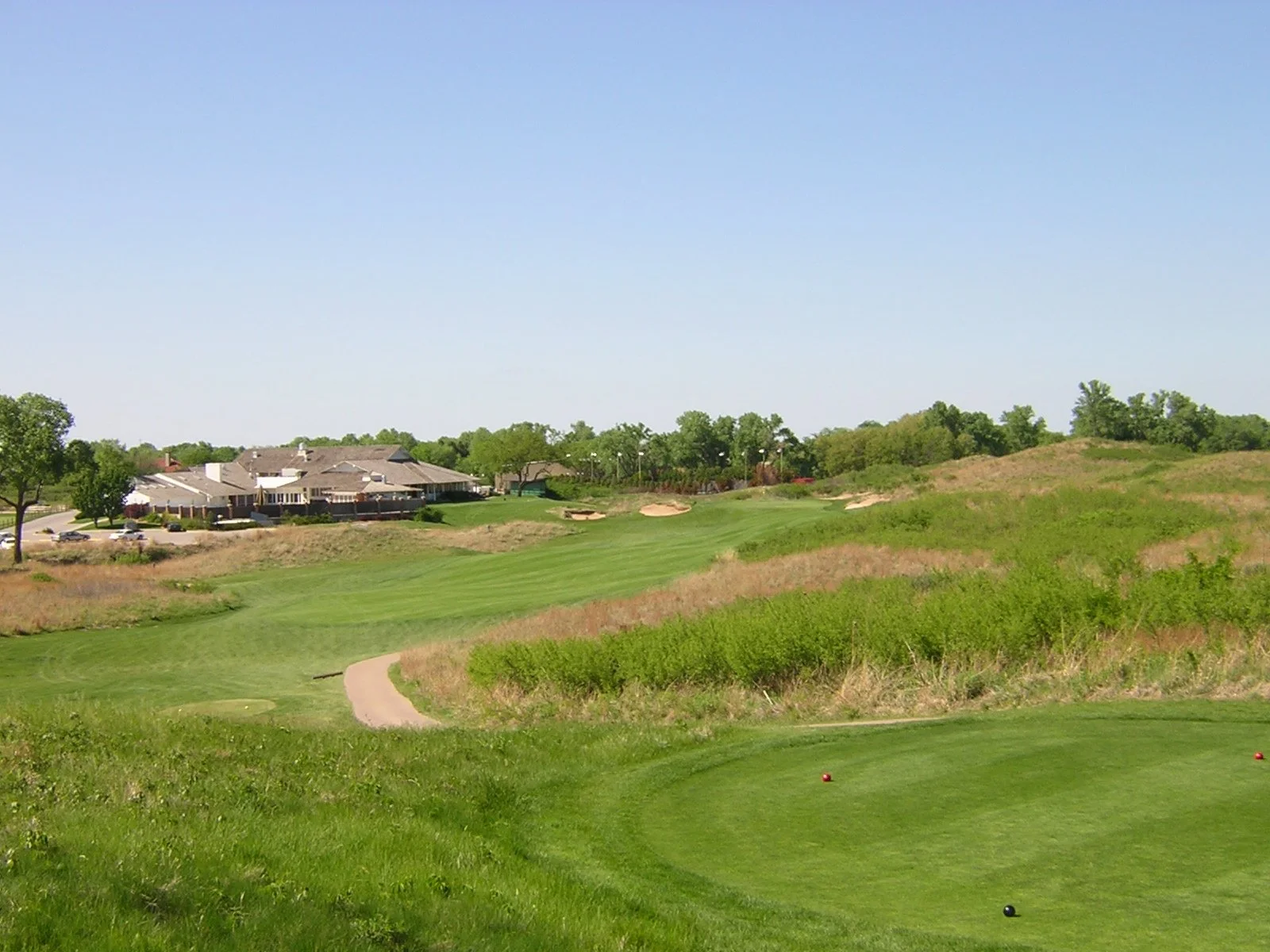PRAIRIE DUNES COUNTRY CLUB
Course Architect(s): Perry Maxwell (1937), Press Maxwell (1956),
Ben Crenshaw & Bill Coore (1980s, 2004)
Year Opened: 1937
Location: Hutchinson, Kansas
Slope: 148. Rating: 75.5
Par: 70
Yardage: 6,947
Hole-by-Hole: 1 - Par 4 452 Yds 10 - Par 3 190 Yds
2 - Par 3 164 Yds 11 - Par 4 535 Yds
3 - Par 4 355 Yds 12 - Par 4 395 Yds
4 - Par 3 171 Yds 13 - Par 4 445 Yds
5 - Par 4 477 Yds 14 - Par 4 405 Yds
6 - Par 4 387 Yds 15 - Par 3 200 Yds
7 - Par 5 512 Yds 16 - Par 4 426 Yds
8 - Par 4 468 Yds 17 - Par 5 523 Yds
9 - Par 4 452 Yds 18 - Par 4 390 Yds
Par 35 3,438 Yds Par 35 3,509 Yds
Events Held: Trans-Mississippi Men's Amateur (1958, 1973, 1987, 1996, 2005),
U.S. Women's Amateur (1964, 1980, 1991),
Curtis Cup (1986),
U.S. Mid-Amateur (1988),
U.S. Senior Amateur (1995),
Big 12 Conference Men's Golf Championship (14-time host),
A.J.G.A. Canon Cup Matches (2000), NCAA Division I Championship (2014),
U.S. Women's Open (2002, 2032),
Missouri Valley Conference Men's Golf Championship (2006),
U.S. Senior Open (2006, 2029).
Awards Won: Ranked #1 by Golf Digest - Best in State (Kansas) (2005-present),
#11 by Golfweek - America's Best Classic Golf Courses (2020-21),
#18 by Golf Magazine - Top 100 Courses in U.S. (2019-20),
#23 by Golf Digest - America's Top 100 Courses (2023-24),
#31 by Golf Magazine - Top 100 Courses in World (2020—21),
#44 by Golf Connoisseur - 100 Most Prestigious Private Clubs in America (2006),
Holes #8 and #10 rated by Golf Magazine - Best 100 holes in U.S.,
Hole #8 rated by Sports Illustrated as one of their Best 18 Holes.
Website: www.prairiedunes.com
HISTORY: When discussing the history of a club, all you have to do is scan over the list of champions and members of the course. An honor roll of past winners of events at Prairie Dunes includes: Jack Nicklaus, Juli Inkster, Gary Koch and David Eger, while honorary members of the course include: Nicklaus, Arnold Palmer, Sam Snead, Tom Watson, Judy Bell and Johnny Miller. That alone should tell you what's in store.
The founder of the Carey Salt Company, Emerson Carey was an avid golfer in the early 1900s, travelling the world to play some of the top courses. The Carey family grew up in Hutchinson, Kansas and helped develop several layouts in the area. In 1935, Carey tapped Perry Maxwell to create what would become his legacy, Prairie Dunes Country Club. Maxwell studied under the one and only, Dr. Alister Mackenzie. The Careys spent much time in Scotland and Ireland,
while Maxwell, who worked with Mackenzie in his construction of Augusta National, made the visit to Scotland, studying the old courses back in the 1920s.
Maxwell, who designed such gems as Southern Hills and Colonial Country Club, was given the task of creating 18 holes out of 480 acres. During his initial visit, Maxwell was believed to have said, "there are 118 golf holes here, and all I have to do is eliminate 100." Stories abound that Maxwell traversed the site for weeks on an artificial leg, toting a bag of apples and a jug of water.
With mules, plows and scoops in tow, Maxwell crafted nine holes in just two years. Quite a difficult process, however, it was just what the Doctor ordered and what would become, "Maxwell Rolls" on the greens and fairways. What's even more amazing is that roots of native grass and weeds were removed by hand! Another astonishing fact is that the course is in the heartland of Kansas, usually a flat piece of country, but not Prairie Dunes with towering sand dunes with elevation changes, upwards of 60 feet, splendid prairie grass, yucca plants and rich plum thickets. When completed, Prairie Dunes resembled more of a seaside course, then what is accustomed to the area. Honorary Club Member Tom Watson commented, "A touch of Scotland in the Land of Oz, Sunflowers instead of Heather. Oceans of Grain instead of the seas. But, like Scotland, be prepared, the wind always blows."
It wasn't until 20 years later that Perry Maxwell's son, Press was brought in to complete the venue, adding the additional nine holes. His father's work, which still remains virtually intact, are holes: 1, 2, 6-10, 17 and 18. Press finished the course, however, it is said that his father routed the entire
piece of property, although the routing plan may not exist.
Prairie Dunes was a huge success right from the start, receiving high acclaim world-wide. It is currently ranked in the top-30 in the world by several publications.
The United States Golf Association first ventured to Prairie Dunes in 1964 for the U.S. Women's Amateur. Six-time Curtis Cup member Barbara McIntire captured her second U.S. Amateur at Prairie Dunes, as she defeated JoAnne Gunderson (Carner), 3 & 2. McIntire, who won her first U.S. Women's Amateur in 1959, won all five of her matches without ever playing the final hole. It should be noted that McIntire captured the 1960 British Ladies Amateur Golf Championship, becoming one of just 11 women to simultaneously hold the American and British titles and earning her the cover of Sports Illustrated magazine.
The USGA once again returned for the 1980 U.S. Women's Amateur, where Juli Inkster etched her name in the history books. Inkster cruised in the opening rounds, winning matches 7 & 6, 4 & 2 and 6 & 5. In her semifinal match, Inkster edged 1973 winner Carol Semple Thompson, 2 & 1 and then knocked off former LPGA player Patti Rizzo, 2-up in the championship. The win was the first of three consecutive U.S. Women's Amateur titles, the first person in 46 years to accomplish the feat and the last to do so.
The 24th staging of the Curtis Cup was held at Prairie Dunes in 1986, as Great Britain and Ireland defeated the United States, 13-5. The U.S. squad included former LPGA standouts; Dottie Pepper, Cindy Schreyer and Danielle Ammaccapane and was captained by Judy Bell. The loss by the Americans was their first setback in this storied event since 1956 and their first loss on American
soil.
The U.S. Men's Mid-Amateur came to Prairie Dunes in 1988, as current Champions Tour player David Eger captured the event. Eger, a two-time winner on the elder circuit and a three-time member of the Walker Cup, defeated Scott Mayne in the championship match, 2 & 1. With the match all square after 14 holes, Eger birdied the next three for the win. Jay Sigel and John Harris, two other players on the Champions Tour, along with Randy Sonnier were medalists with a score of even-par 140.
The United States Women's Amateur made its third visit to Kansas in 1991. Even par was the low score for qualifying, as Amy Fruhwirth was medalist. Three former champions of this event advanced to match play, Catarina Quintarelli, Carol Semple Thompson and Vicki Goetze, however all three would fail to advance to the second round. Fruhwirth reached the championship match with ease, dispatching of Martha Leach, 7 & 6 while Heidi Voorhees defeated Martha Lang 3 and 2 to advance. During the 36-hole final match, Fruhwirth dominated, as she opened up a 5-up lead after 10 holes. Voorhees trimmed the advantage to just 2-up after 25 holes, however Fruhwirth went on a birdie binge with four straight birdies to take a 6-up lead, en route to a 5 & 4 win.
The 1995 Senior Amateur was the next major event to be held at Prairie Dunes. With over 2,000 entries, James Stahl, Jr. defeated Rennie Law, 2 & 1 for the title. Prior to the final day, in which both the semifinals and final were to be played, Stahl discovered that an old fried, former Mid-Amateur Champion Danny Yates had arrived and was to caddie for Stahl. During the semis, Stahl
did not lose a hole against Curt McClure and won the match, 4 & 3. The final match was different, as Stahl bogeyed four of the first seven holes, but still he held a 1-up lead. Law's play improved and by the 12th hole, Law was 2-up. After winning the 13th, Stahl birdied the 14th to square the match. On the 16th, Law missed his par putt to fall 1-down and Stahl birdied the 17th from 10 feet to seal the win. It should be noted that Stahl was runner-up in 1995 at the Senior British Amateur.
For the seventh time, the USGA returned for the 2002 U.S. Women's Open. Juli Inkster, 22 years removed from her U.S. Women's Amateur title at Prairie Dunes, turned in a performance of a lifetime, as she took down the best player in the world, Annika Sorenstam with a stunning Sunday 66. Trailing Sorenstam by two shots heading into the final round, Inkster gained one with a birdie on the par-three second. The two-time U.S. Open champion then drew even with a birdie on sixth. Sorenstam, playing in the group behind Inkster, stumbled with a bogey on eight and the lead was Inkster's. With a birdie on 11 from eight feet, Inkster reached four-under-par and held a two-shot advantage. Sorenstam birdied the 14th to climb within one, as Inkster was struggling on 15. Her chip on the par three slipped 11 feet past the hole, but she knocked in the par putt to keep the lead. Sorenstam missed the green on the 15th, but chipped to within three feet. However, she failed to convert and the lead was again two.
Inkster then clinched the title with a four-time, fist pumping birdie from 21 feet on the 16th. Sorenstam continued to press and her birdie on 17 got her within two, however that was as close as she came. For the week, Inkster did not three-putt a single green, posting an amazing 39 one-putt greens in 72 holes. With the win, Inkster became the second-oldest Women's Open champion, behind only Mildred "Babe" Didrickson Zaharias (1954). In defeat, Sorenstam was the only player in the field to shoot all four rounds at par or better. For the week, Prairie Dunes played quite difficult, as only two players broke par and the cut line was at plus-nine. First-round co-leader Shani Waugh finished alone in third, seven shots back.
In 2006, the U.S. Senior Open made its first appearance at Prairie Dunes, as Allen Doyle defeated Tom Watson down the stretch to win this championship for the second straight year. After an opening round of 70, Watson posted back-to-back 66s to hold a one stroke lead over Doyle and by three over Loren Roberts, who carded a third-round 62. Paired together during the final round, Watson three-putted two of the first three holes and never recovered, as he shot 72 compared to Doyle’s 68.
The USGA has awarded Prairie Dunes with a pair of major championships, as it will host the 2029 U.S. Senior Open and the 2032 U.S. Senior Women’s Open. “The USGA is pleased to reunite with Prairie Dunes Country Club and continue what has been a long and mutually beneficial partnership that began nearly 60 years ago,” said John Bodenhamer, USGA chief championships officer. “We know that Prairie Dunes, its surrounding community and the entire state of Kansas will be thoroughly engaged in hosting the best senior players from around the world. In addition, Prairie Dunes remains committed in its support of both amateur and professional competition.”
REVIEW: It is said that Sam Snead after his first glance of the narrow fairways at Prairie Dunes, turned to the gallery and commented, "OK folks, we'll have to walk single file today."
Standing on the first tee, you're able to visualize what's in store, as several holes are in full view. The opening hole starts off with a sharp dogleg to the left, stretching a modest 452 yards from the back tees. The fairway bunkers down the right side are a perfect target to shoot out, as you
draw the ball from the tee. A medium- or short-iron will remain to a slightly elevated green, that's 28 yards in depth and slopes from the center to the front and away left and right in the back.
The first of four sensational par three's, the second is the shortest at just 164 yards. When the wind is up, this hole could be one tough hombre, as four deep bunkers are well below the two-tiered putting surface. Any shot long could result in an unplayable lie. The green is one of three on the front nine that's only 26 yards in depth.
From the highest point on the course, the third hole presents a visual sensation that's not to be believed. The beauty of Prairie Dunes stands out in all its glory. The carry from the back tee over the deep thicket and brush is 210 yards, so just a three-metal to a fairly wide fairway, will set up a short
wedge. The putting green is long and narrow and falls off severely in the front. Three deep traps guard the entrance to the surface, making a front flag quite difficult.
"Hill Top", the apply named par three is next and is quite similar to the second hole. The hole plays longer than the yardage indicates due to the uphill lay of the land, not to mention the long, left-to-right green that's fronted by a pair of deep traps below the surface. The undulating green is quite tricky, featuring a ridge on the left. Missing this green long and right is jail, so play below the hole if possible.
From an elevated tee, the fifth is a straight-forward par four, featuring a wide fairway that slopes from left to right. Even with a successful drive, a mid-iron awaits, depending upon the wind, to an uphill green that slopes from back to front and is quite narrow and long (34 yards deep). Let's not forget the two deep traps that guard the front of the surface on either side. By the way, long of this green is quite a mistake.
Another spectacular setting, the sixth features an elevated tee on a slightly dogleg left par four. A big drive down the right side, avoiding the bunker on the left, will set up a short-iron to a short, narrow green. During the 2002 U.S. Women's Open, Juli Inkster sank a 65-foot chip from right of the green to tie Annika Sorenstam for the lead en route to victory.
The first par five on the course, the seventh can be had, but...Usually playing downwind, hitting this fairway off the tee is of utmost importance, as thick native grasses flank both sides to the green. The putting surface is long and narrow and guarded by sand on both sides. The smart play would be to layup 90 to 100 yards short of the green and pitch up to the hole, thus giving yourself the best shot at birdie.
Probably the most famous hole on the course, the eighth is a dynamite par four, displaying Maxwell Rolls more than any other hole. From the tee, the hole plays uphill to a ribbon-rolling fairway that doglegs right to the green. From the fairway, take an extra club to reach the surface, as four traps lay below the sloping green. There is no bailout to the left, as deep thicket and a trap await. There is no doubt that this is the hardest hole on the course. It comes as no surprise that Sports Illustrated picked this hole for one of their "Best 18 Holes in America."
Playing back towards the clubhouse, the ninth features another elevated tee box, looking down, yet another rolling fairway. The landing area is fairly generous, however any shot off line will end up in waist-high grasses. A medium-iron will remain to a fairly long green, that slopes hard from right to left. During his last exhibition at Prairie Dunes, Jack Nicklaus made an eight on the ninth.
Just behind the clubhouse is the 10th tee. Following his design of the hole, Perry Maxwell called this par three the best in America. It surely ranks up there with the 12th at Augusta, 16th at Cypress Point and the 17th at the TPC of Sawgrass. Playing straight uphill, this devilish one-shotter is quite difficult, as the whole putting surface is not visible from the tee. Bunkers, short-right and left guard the small green that slopes from back to front. Making par here is quite a feet.
The only hole with water, although it does not come into play, is the rugged, dogleg-left par-four 11th. At 452 yards, it is tied with the ninth as the longest par four on the course. A big drive down the fairway will be required to have any chance of making par, as a difficult, horseshoe bunker guards the left corner of the dogleg. A long-iron approach is next, which needs to negotiate the slightly elevated surface of the green. Two very deep traps, right and left protect the multi-tiered green, that is just 26 yards deep.
The climb to the 12th tee from the previous hole is up a shoot of steps to an elevated tee box that overlooks the short, but tight par four. Although the fairway is wide, don't be fooled as your approach from the left or right side of the fairway will be blocked by tall cottonwood trees. Thus, the play is fairway-metal or long-iron off the tee, setting up a short-iron to the tiniest of greens. At just 25 yards in depth, this severely sloped putting surface can be quite difficult.
A tough driving hole, the 13th is anything but lucky. First off, three traps and deep rough guard the right landing area. Next, more deep rough and another bunker protect the left. Let's not forget the narrow landing zone to shoot out. With a successful tee ball, a slightly uphill second remains to another small green that cants severely from back to front with a couple of distinct ridges. Any ball on the front edge, will roll down back off the green.
Despite playing as the shortest par four on the back nine, the 14th requires pinpoint accuracy off the tee. The problem is that it's a blind shot over the hill to the fairway. The play is a draw on this dogleg left, avoiding the deep rough and sand down the left side. Although the rough is thick on the right, at least par is still in the mix if you block your tee ball. The putting surface is one of the longest on the course and is slightly elevated from the bottom of the fairway. The green is surrounded by tall trees and a pair of deep traps. A large ridge in the first quarter of the green makes reading this putting surface a challenge.
Nicknamed aptly, "The Chute", the final par three on the course plays from a towering stand of trees on either side of the tee box. Uphill and into the wind, it's hard to believe that this is the highest handicapped hole on the course. A long-iron or fairway-metal is needed just to reach this miniscule putting surface. To err on 15, go left, as two difficult traps stand ready on the right. The good news, the green might be one of the easiest on the course.
The final of the seven par fours over 400 yards, the 16th is a dogleg right, playing back into the wind. The unusually wide fairway does boast a bunker on either side with tall native grasses down the entire length of the hole. A large ridge in the center of the fairway stands 260 yards out from the tee. Your approach will likely be with a mid-iron to a long, narrow green with sand both left and right. The putting surface slopes from left to right. A tough hole with the tournament on the line.
Once again, the "Maxwell Rolls" are quite evident on the 17th, the final par five on the course. One of the more deceiving tee shots on the course, as upon first look, there seems to be more landing area than there is. The hole bends slightly left from the back tees and plays uphill after your opening shot. The elevated green can be reached in two, however it's just 29 yards in depth and is quire narrow. Sand and scrub are left and right of the green falls sharply downward, making for a difficult up and down. Birdie certainly, but don't be disappointed with par.
A classic finishing hole, the 18th is a gem with the setting sun to the left. The elevated tee shows the entire hole and what's ahead of you. The rolling fairway is quite wide, but that's where it ends. Devoid of bunkers, the fairway sports deep rough left and tall native grasses right, making for an anxious tee shot. The hole bends to the right off the tee and slopes uphill to the green from the fairway. Three difficult bunkers guard the right portion of the putting surface, while one deep, diabolical bunker lays left. The putting surface is narrow and just 29 paces deep, as it slopes from right to left. According to local lore, the 18th was once aced by former assistant pro, Tom
Pomransky.
FINAL WORD: I'll be the first to admit that I had heard of Prairie Dunes since we cover all aspects of golf at The Sports Network. But, I will also admit that I failed to know much about the course, other than it was in Kansas.
Prairie Dunes is a fantastic seaside course. One problem, there is no water. Although I have never played in Scotland, I am told that this is as close to a Scottish-type course that it can be. This is a perfect example of links design, something Perry Maxwell was interested in bringing to the United States.
Not long by today's standards, Prairie Dunes can play as difficult or harder than most courses in the country. How hard is Prairie Dunes? The first nine times Jack Nicklaus played the course, he never shot par! Peter Jacobsen, the 2004 U.S. Senior Open champion, upon a recent visit to Prairie Dunes said, "This is truly one the most interesting and challenging courses in the United
States and certainly fits in the "links" genre along with Pacific Dunes, Cypress Point, Pebble Beach and Whistling Straits."
From the elegant, but not overstated clubhouse, to the accommodating staff and of course, the incredible golf course, Prairie Dunes is marvel and a testament to golf. Major champion, golf architect and historian Ben Crenshaw commented, "Anybody who has ever visited Prairie Dunes will be treated to real golf; the kind that tests your brains and body. Yes, this is golf of the first order."
There is no course in this country quite like Prairie Dunes and for it to be in the Kansas of all places, well, you get the picture. This is a masterpiece, a Rembrandt, an architectural marvel. Every hole is magnificent. Rolling pieces of carpet fairways, stunning native grasses and Yucca plants, plum thickets, groves of towering cottonwoods and sizzling greens. Prairie Dunes is one of my all-time favorite courses. Please invite me back!

